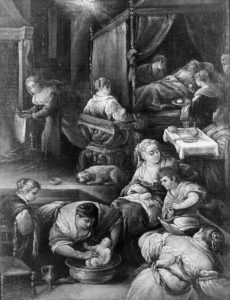 Reading Giving Birth in Eighteenth-Century England is a rich immersive, sensory, and visceral experience. Sarah Fox’s rigorously-researched exploration of the physicality, materiality, and communities involved in the processes and emotions surrounding late pregnancy, childbirth, and lying-in is a model of how to approach the history of embodiment and the work of birthing.
Reading Giving Birth in Eighteenth-Century England is a rich immersive, sensory, and visceral experience. Sarah Fox’s rigorously-researched exploration of the physicality, materiality, and communities involved in the processes and emotions surrounding late pregnancy, childbirth, and lying-in is a model of how to approach the history of embodiment and the work of birthing.
As Fox points out, embodied readings arise from a “corporeal map that we have assembled from biological and cultural data that we have been gathering since birth”, which condition us to “feel” certain things in connection to birth, and to historical accounts of birth. Recognizing that we cannot “feel” or access birth in the past in the same way as historical birthing bodies, Fox openly and carefully reflects throughout on the complexities of negotiating between “embodied birthing” and reading now, and in the past, stressing the dangers of using “one’s own body as a bridge to past bodies”, as she navigates the negotiated process of birth in eighteenth-century England. In so doing, Fox judiciously and successfully builds on existing historical work on bodies, embodiment, birth, and midwifery including Barbara Duden, Lyndal Roper, Adrian Wilson, Karen Harvey, and Mary Fissell, adding greatly to our understanding of giving birth in eighteenth-century England. Giving Birth is, in short, a consummate example of how to centre birthing women’s voices and experiences in historical analysis and of how to negotiate the process of writing authentic embodied histories.
Framing birth as a process, rather than an event facilitates Fox’s analysis of the work of negotiating birth as both transient and longer-lasting for the mother, the family, the material household, and the wider social community. Giving Birth guides the reader through the various stages in the process of birthing, rooted in what Fox calls ‘non-exceptional areas’ in the north of England, away from capital cities and obstetric centres, in spaces and locations where male and female medical practitioners co-existed. She draws attention to the complex ways in which local geographies and environments dictated who was present at births, shaping struggles for co-existence, not displacement. Firmly rejecting the replacement thesis of female midwives by man-midwives, she argues that the former remained a “consistent and authoritative presence” into the late eighteenth century. Fox also articulates the ways in which locality – food, drink, water, and customs, impacted the birthing experience for women, their families, and communities.
Birth, Fox argues, played a central role in shaping local neighbourhood networks and eighteenth-century society more broadly. It also shaped, and reshaped the birthing body, familial dynamics and relationships, sleep patterns, and the material organization of domestic spaces as ‘makeshift’ objects were recast and recycled for different purposes by family and community members managing the practical, ritual, and social aspects of childbirth according to their economic situation. Giving Birth similarly reshapes our understanding of the history of birthing. Weaving together an engaging, evocative, accessible, and grounded history of the sounds (groaning chairs), sights, smells, language, and taste (caudle) of the birthing process, with practices of emotional, material, and physical care, love, and neighborliness Giving Birth is a must for students and scholars of the history of childbirth, pregnancy, midwifery, embodiment, material culture and communities.
Cathy McClive is an associate professor at Florida State University. She is the author of Menstruation and Procreation in Early Modern France (Routledge, 2015).
